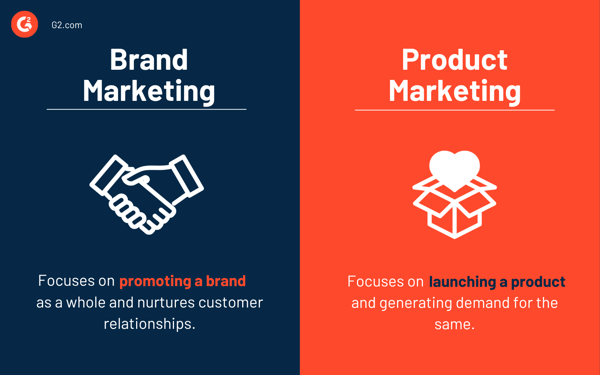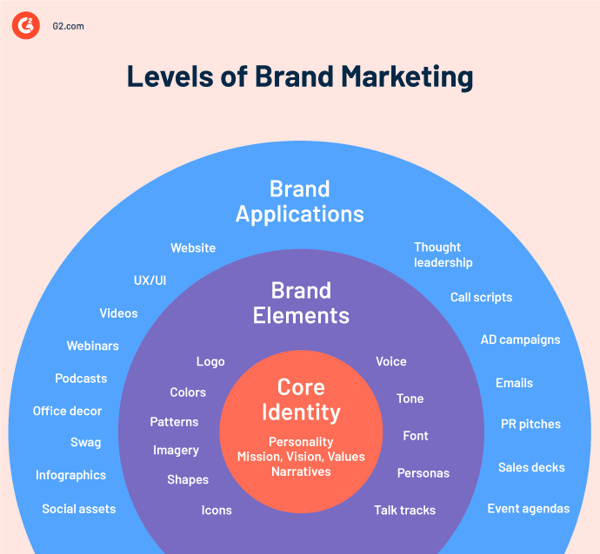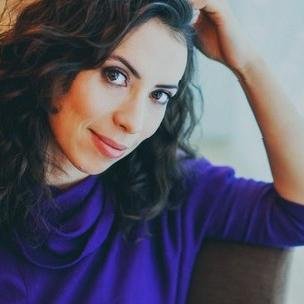July 19, 2024
 by Jordan Wahl / July 19, 2024
by Jordan Wahl / July 19, 2024

Your brand isn't just a logo, it's the feeling you evoke, the values you champion, and the story you share with your customers. It's what makes them connect with you on a deeper level.
When you learn to tell your story right, brand marketing becomes less about shouting and more about creating a conversation. It's about forging a lasting connection with your audience.
Brand marketing involves long-term strategic planning to promote a brand as a whole instead of marketing individual products or services. It shares a compelling story to generate brand awareness among prospects and build a reputation.
Consumer-facing brands use brand intelligence software to understand what people think about their brand and gain insights to improve their marketing efforts. Having a well-known brand gives businesses the biggest competitive advantage.
Contrary to popular belief, brand marketing is not about plastering your company logo everywhere and hoping that people see it. It’s about tapping into feelings, and we all know how complicated feelings are. But to market your brand well, you have to meet your customers on an emotional level.
So, how do you get an audience’s attention when you sell in a crowded market? Market your brand by evoking positive feelings about what you do.
The term “brand” is widely used but rarely well understood. So, here’s a quick recap of its origin.
More than a century ago, cattle ranchers started marketing their animals with a branding iron to signify which animals were theirs; a trademark, if you will.
Years later, as consumer goods increased, producers emulated this by putting their unique mark on their products. The purpose was to indicate the product's source and differentiate it from similar goods in the market. With that, a brand became the non-generic name for a product that tells consumers the source of the product.
Fast forward to today, the term brand has taken on a new meaning to people. You see, a brand is not a logo. It’s not an identity. It’s not a product. Instead, it’s a promise to your customer. Your brand is not only an embodiment of who you are as a company but also who your customers are as users. Therefore, you owe it to them to represent yourself responsibly.
Simply put, a brand is what connects a product to its customers. Your brand is the personality of your company. It's communicated through logos, colors, brand name and taglines and represents who you are and what you do.
Brand marketing and product marketing are both essential to a company’s overall digital marketing goals and business plan. But they do differ from each other in how they function.

Product marketing is a narrow approach. It focuses on launching and promoting a single product or a family of products. The strategy targets demand generation and communication of benefits for a particular product, not the brand as a whole.
Brand marketing focuses on elevating the perception stakeholders and customers have of the entire company and not just one product. It uses insights from product marketing to deliver a wholesome experience that builds customer loyalty and nurtures relationships between an audience and a brand.
Your brand strategy is one of the most important parts of your marketing plan. Your secret weapon, if you will. Its purpose is to create long-term relationships with your customers so that you can ultimately build a brand that they trust.
A well-planned and executed brand strategy can make or break your business. If you do it right, you’ll keep your customers happy and your company thriving for ages.

So how do you build a brand that your customers can stand behind? There are seven steps involved.
You must understand your purpose before you can build your process. It’s what sets you apart from the competition. When you articulate what you wish to achieve with your brand marketing efforts, you can determine the tactics and processes to support your goals.
Once you understand your company’s core identity, you can move forward strategizing your brand language and elements and how you can apply them.
Rule number one of any business strategy is to be aware of the competition. You are in the same business, targeting the same people - so the best way to stay ahead is to study them closely.
Conducting a competitor analysis is not about getting intimidated but about staying motivated and developing a unique strategy that sets you apart.
Don’t put your customers in a position where they have to connect the pieces of your brand. Maintaining brand consistency fuels recognition which in turn will enhance loyalty. A cohesive brand messaging will support your brand marketing efforts by making you recognizable.
Be it in the form of colors and fonts you use or the message you promote, give an aligned experience to your audience to benefit from it in the long run.
Consistency isn’t limited to your brand’s color palette but applies to how your employees represent it. Your customer relations experts should be well-versed in communicating with people and sending the same message.
Establish brand guidelines for your employees as a roadmap to represent your brand consistently across all channels. These guidelines also help when onboarding new employees.
Finding ways to connect with your customers emotionally can go a long way in building loyalty and brand awareness in marketing. Make them feel heard by addressing their pain points. Make them feel like they are part of a community that cares about them.
Emotions play a big role in a customer’s buying decisions. So, bringing it into your branding strategy will foster your customer relationships.
The business world is more dynamic than ever. So, to survive the changing trends, you must remain flexible in your approach. The idea is to accept if things aren’t working and be adaptable enough to bring a change.
There might be a whole new audience dynamic that you can tap into by tweaking your messaging a bit or changing your product design. Flexibility doesn’t have to intervene with your efforts to stay consistent.
Loyalty is the core of brand marketing. And rewarding customer loyalty is one of the easiest ways to nurture relationships and yield benefits in the long run. These are the people who will support your brand through word-of-mouth marketing to potential customers.
Many e-commerce websites use rewards and incentives software to provide special perks to loyal customers. Additionally, sending them exclusive deals and merchandise, or sometimes even acknowledging them through a thank you email, helps.
is the average revenue increase for businesses that maintain brand consistency.
Source: marq.com
Brand positioning is the process of establishing your brand in the mind of your customers. It’s not merely a promotional tactic but the foundation of your brand’s competitive strategy.
Your brand will be positioned by customers regardless, so the more proactive your company is about developing a solid brand position, the more successful and consistent your brand exposure will be across channels. Strategic positioning not only defines how your audience perceives you but also amplifies visibility, helping your brand break through a saturated market.
While positioning your brand, you must determine how to differentiate in the eyes of your target customers. Why are you unique? What makes you better than your competitors? What do you offer that others do not? Clear, differentiated positioning strengthens brand exposure by ensuring your messaging resonates and sticks with the right audience.
If you're in the early stages of building a company (and subsequently, your brand), use A/B testing software to try out a couple of different statements and let your customers choose.
An essential step in this process is to have a positioning statement and a value proposition. Although commonly used interchangeably, they are different.
Your value proposition should represent the “big picture.” It reflects what your brand is promising to deliver and the range of benefits you offer. It’s arguably the most important element of your marketing messaging.
For example, Starbucks differentiates itself from competitors by creating a unique value proposition of becoming the “third place” for customers, after home and the workplace. Purchasing a cup of coffee is an “affordable luxury” and an experience. Customers can order customized drinks and enjoy the beverage in a relaxed, upscale environment. They've solidified this brand positioning through content marketing.
Your positioning statement, on the other hand, is a subset of your value proposition. Unlike your value proposition, it focuses more on the specifics of your competitive differentiation. The positioning statement usually includes the target audience, product name, benefits, and competitive differentiation.
For example, Kate Spade's positioning statement combines a playful, sophisticated personal style with high quality and long-lasting utility for the young professional fashionista. Your value proposition and statement help set you apart from competitors in the industry.
Be sure to put time and effort into constructing a solid brand positioning for your company. It’s key to long-term success against your competitors.
Jeff Bezos
Founder & CEO of Amazon
Brand marketing is about taking your customers on a journey with you - a journey of building the brand you aspire to be. Your brand is not only what you are today but also what you want to be down the road, and your customers can help you build and market that.
Start by asking yourself who you really are. Identify your core values and your personality. Figure out who you are as a business and what you aspire to be. Then, be the same for your customers.
Think of brand marketing with several layers where everything radiates out from the core.

You can tap into several resources to understand how your brand is perceived. But the key is to reflect both internally and externally. Look at online customer reviews of your company, talk directly with customers, and speak to your internal team to understand the current perception of your brand so you can identify what areas need changing.
For example, you can spend time on your company’s social media pages searching through reviews and looking for common themes on what people care about. From there, you can pull out themes to narrow down the core messaging (that’s authentic) and take your brand to the next level.
Once you understand how your brand is currently being perceived and where you want to be as a brand, represent that desired personality and feeling. Find elements that match that feeling and utilize it in your culture and messaging to evoke emotions that relate to your brand and customers.
The keyword here is feelings. If you fail to meet your customers on that level, you’re selling your brand short.
Establishing a brand that tells your story right can be tricky, especially when entering a competitive marketplace. But if you have a promising story to tell, you can consider strategic branding to connect with those who care.
When you have something unique in a saturated market, you have a higher selling power and brand value than the rest. Remember to keep your customers at the center of your decision-making tactics to foster brand advocacy and customer loyalty.
Explore top marketing automation software to boost productivity and focus on what matters.
This article was originally published in 2018. It has been updated with new information.
Jordan Wahl is a former content manager at G2. She holds a BBA in Marketing from the University of Wisconsin-Whitewater. She loves anything that puts her in her creative space. including writing, art, and music.
Green isn’t a trend. It’s a test. And right now, your customers are watching to see if your...
 by Lesley Vos
by Lesley Vos
Brand exposure is one of the most critical yet often underleveraged drivers of marketing...
.png) by Devyani Mehta
by Devyani Mehta
Building a brand is a delicate process.
 by Hannah Tow
by Hannah Tow
Green isn’t a trend. It’s a test. And right now, your customers are watching to see if your...
 by Lesley Vos
by Lesley Vos
Brand exposure is one of the most critical yet often underleveraged drivers of marketing...
.png) by Devyani Mehta
by Devyani Mehta


